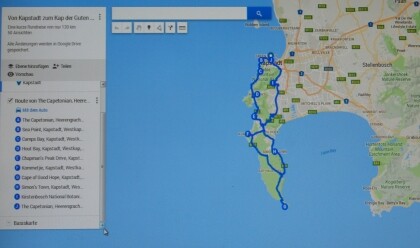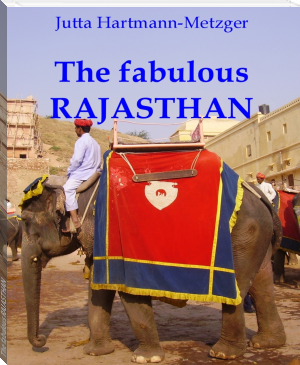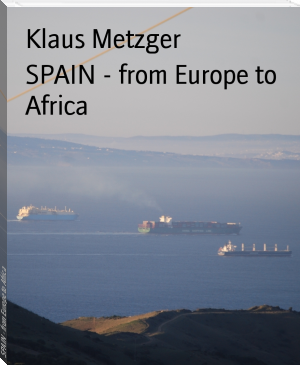South Africa - Land of the Opposites by Klaus Metzger, Jutta Hartmann-Metzger (graded readers .TXT) 📖

- Author: Klaus Metzger, Jutta Hartmann-Metzger
Book online «South Africa - Land of the Opposites by Klaus Metzger, Jutta Hartmann-Metzger (graded readers .TXT) 📖». Author Klaus Metzger, Jutta Hartmann-Metzger
Caravelle replica in the Dias Museum
In the Dias-Museum (which we have visited) is a original replica of the Caravelle, which can be visited. On 8 November 1987 a crew of 17 members from Lisbon sailed with the replica in the direction of South Africa. On February 3, 1988, the team with the Caravelle arrived in Mossel Bay. In the Dias-Museum (C) there are numerous references to the history of the sea from the early days of the Portuguese, Dutch and English adventurers.
After Vasco da Gama discovered the sea route to Asia in 1498, King Dom Manuel I Cabral was appointed commander of the second royal Portuguese fleet in India. He traveled in diplomatic missions. Cabral was to gain peace and friendship for the Portuguese crown and build a trade route for spices from Calicut (Kozhikode on the Malabar coast of India).
Post-Office-Tree
The Portuguese, Pedro de Ataide, commander on one of Cabrals ships, left an important letter in a shoe at the large post-tree in Mossel Bay in 1500 on his return from Far East. In this letter, Ataide warned of problems near Calcutta. In 1501, Joao da Nova (commander of the Third East India Fleet) found this letter on the way to India. This is the first post office in South Africa. The huge post-office tree is still in the garden of the Dias Museum, which also contains the spring from which Bartolomeu Dias supplies fresh water in 1488 has.
Swellendam
We were a little in a hurry, because our tour guide, Brigitte, had learned that on the Tafelberg ideal weather conditions and visibility would prevail. That is why we had to arrive in Cape Town around 4:30 pm to get to the cableway in time. So we had a short stop in Riversdale (D) and 2.5 h later in the small town of Riviersonderend (F), where there were excellent, filled pies. Halfway between Riversdale and Riviersonderend we briefly visited the third-oldest city of South Africa, Swellendam (E). I already described this in my 7th chapter "Through the" Little Karoo "in the East of South Africa".
Cableway to the Table Mountain
As always with such sitings: on the city motorway in Cape Town there was a truck accident that lost its empty bottles, so we arrived only half an hour later at our already known Capetonian Hotel (G). With the already waiting taxis we drove to the valley station of the cable car. Unfortunately, we could only stay on the Tafelberg until about 6 pm and enjoy the wonderful view. The last train was already at 7 pm. Thus the planned recordings of the sunset had to fail. Nevertheless the whole day was full of impressing experiences.
9. From Cape Town to the Cape of Good Hope in South Africa
Cape of Good Hope
This was to be an exciting day, because the visit of the "Cape of Good Hope" was on the agenda. The starting point, the Capetonian hotel we already three days before during our intermediate stop in Cape Town on the way to the "small Karoo" met. This time we got a much nicer, more spacious room at the Capetonian Hotel (ideal for the last three nights in South Africa we should stay at this hotel). However, we realized that our hotel was not in the "outing area" because there were numerous criminal elements around, which one should avoid especially at night.

From the Capetonian Hotel (A), which is located in the middle of the city center, under the high-rise buildings of the business district, we drove by coach to the sea to Sea Point (B). From there you had a wonderful view of the Atlantic. When we visited the table mountain with the cable car (previous afternoon) I always fell from the distance the imposing, round stadium of Cape Town. It is located in the neighboring district of Green Point.
Stadium of Cape Town (view from Signal Hill)
In the small village Clifton (on the way to the Cape) you could win a very beautiful impression of the mountain chain "Twelve Apostles", which is located next to the Table Mountain. This tour was a perpetual dream with wonderful impressions. This was shown in the following Camps Bay (C) to which an interesting story was told. Because the impressions were so intense, we set our first break.
The beach at Camps Bay
Around 1800, this beautiful bay belonged to the Kamptz family. It was only in 1884 that a connecting road to Clifton was built with the aid of convicts. On this way we came on the trip to the Cape of Good Hope to today's "Camps Bay". We quickly realized that this bay is one of the most beautiful and sought-after places in Cape Town.
Seal feeding in the Hout Bay
With the next stop, in Hout Bay (D), we were again offered a special attraction, which we could experience right on the harbor basin: It is certainly very funny to observe the trained seals in the harbor basin while snapping at the small fish portions. A reference person kneels on the basin with the fish in mouth and the animals leap from the water to take over the prey. This process is also very dangerous. Some time ago a tourist was bitten off as she wanted to feed the seals using this method. There were several seals in the harbor basin. A larger collection can be seen on the seal island Duiker Island. From the harbor a small boat goes. We found the dressage act in the port pool sufficiently.
Hout Bay with the "Lion's Head" at Cape Town
Over the impressive Chapman's Peak Drive (E), the trip continued to the Natureservat "Cape of Good Hope" with the southern tip. This unique Panoramastrasse is a nine kilometer long coastal road on the Cape Peninsula south of Cape Town. It winds in 114 curves directly between sea and steep rock faces along Hout Bay to Noordhoek (north of Kommetjie) and leads over Chapman's Peak, a 160 meter high viewpoint. Numerous tourists travel daily this route and many autocones turn to this backdrop advertising shots.
Chapman's Peak Drive and Table Mountain
Although the construction of the road seemed initially impracticable, the project succeeded under the direction of the geologist Charl Marais. Construction work began in 1915 under partial life-threatening working conditions on the steeply sloping stone slopes. Seven years later, in 1922, the road could be opened to traffic. Despite the prescribed top speed of 20 km / h, the ride over the Chapman's Peak Drive was not safe. Again and again rockfalls fell down and killed people. In the rainy road, many cars were slipping, bouncing against the rocks or falling into the depths.
The accidents accumulated and when thirty-five percent of the route was spilled in January 2000, the road was blocked. As the public authorities were unable to raise the funds for the renovation, the street was leased to a private consortium for 30 years. The Ltd. Entabeni invested over 150 million rand in the conversion of the road. Large giant nets were installed for falling rock, and a tunnel or half-tunnel was blown into the rock at two particularly dangerous sections. In December 2003, the Chapman's Peak Drive was again opened to traffic. In order to amortize the high renovation costs, the single trip for cars over the Chapman's Peak Drive currently costs 42 marginal toll charges. As we wanted to go south on the Atlantic side, we passed through the small town of Kommetjie (F), which was situated on beautiful, secluded sandy beaches
The sandy beaches of Kommetjie
After the North Cape (1977) and Gibraltar (2012) the trip to the Cape of Good Hope was particularly exciting. We took our time and enjoyed the view of the rocks, which had caused so many difficulties for the early sailors on their way to India from a bench. A well-known example was the Portuguese Bartolomeu Dias, who desperately sought fresh water and landed in the eastern Mossel Bay. In the Dias Museum there is a replica of his Caravelle, with which he circumnavigated the southern tip for the first time in 1487/1488. Interesting was also the hiking trail (Scenic Way) from the higher parking lot to the beach with the bird island. Finally, there was still a memorial certificate (for early bookers until 31.08.2014).
Visit of the Cape of Good Hope on 17 October 2015
At the "Cape of Good Hope"
A wild baboon
As we headed north along the "Cape Point Road", we met a group of wild baboons, which we could only photograph from the bus. Our round trip continued to Simon's Town (Boulder's Beach) along False Bay on the east coast, where we wanted to visit penguins. The first penguins at Boulders Beach appeared 1983 as a pair. In the meantime, the colony of this African species has considerably increased. The beaches are very easy to reach over wooden bridges and the animals behave very calmly and can be easily observed.
Penguins at the "Boulders Beach"
Almost back to Cape Town (overall we had covered 130 km on this tour), we had to visit the last attraction of the day, the Botanical Garden of Kirstenbosch (I). Cecil Rhodes (whom I have mentioned several times), the mining magnate and prime minister of the Cape region, bought the area east of the Table Mountain in 1895 to prevent further colonization. After his death, the area came into the hands of the state in 1902. On July 1, 1913, Kirstenbosch National Botanical Gardens was founded. Today, this is a magnificent plant with a beautiful collection of colorful Protea plants (the national flower of South Africa).
In the botanical garden of Kirstenbosch
The food at the Capetonian Hotel (J) was not very varied and was served in the relatively small club room (around classes we found the breakfast in the





Comments (0)